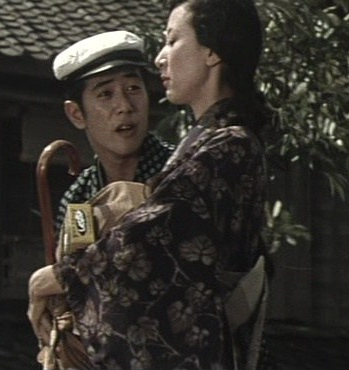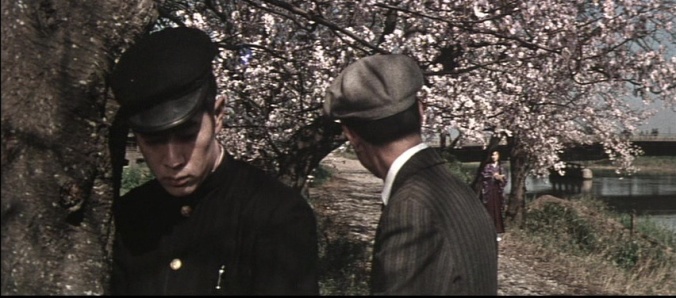 Fascinating and in many ways groundbreaking, Her Brother is the first movie I have found from Japan that portrayed what we now would recognize as a realistic, believable portrayal of teenagers within a family setting.
Fascinating and in many ways groundbreaking, Her Brother is the first movie I have found from Japan that portrayed what we now would recognize as a realistic, believable portrayal of teenagers within a family setting.
Gen is the daughter of the family, when we begin the movie still in high school and about two years older than her brother Hekiro, who is something of a scamp. Their father is a famous writer, so they live in middle-class comfort in the 1920s, but the father’s attitude to child rearing has been that boys will be boys and whatever problems Hekiro may have, he will grow out of them. He did remarry when his wife died, but the stepmother has proved unable or unwilling to take care of the children due to extreme rheumatism and bouts of religious obsession. Thus, the kids have essentially grown up on their own, with Gen acting as sometimes an older sister, sometimes a surrogate mother.
The remarkable aspect of their relationship is its variety. The two share their frustration with both parents, their emotional ups and down, and even have their private jokes. There is also a considerable amount of teenaged angst and confusion, with real arguments and even a childish fight. And when they laugh together, they seem to be really laughing — Japanese women in films up to this point have a little “tee-hee-hee” sound they use for laughter, while men tend to use the “ha-ha-ha” formulation, as if reading syllables from a script. Thus, as with Giants and Toys, the appearance of genuine, uncontrolled or unscripted laughter is almost a shock. Hekiro of course takes advantage of Gen, but there is never the slightest doubt that both love each other and we often get the feeling that he is really just trying to get his father’s attention and love. In other words, a pair of siblings Americans would recognize in their own families, yet utterly Japanese in every outward aspect. They are teenagers, but not American teenagers; for one thing, even though they obviously love each other and play with each other, they never, never, ever touch each other, not even when Hekiro is on his deathbed. Nor do the parents ever touch each other or the kids, even in the hospital.
Unfortunately, the movie does need a plot. Hekiro’s problems gradually increase, and we eventually wander into tear-jerker territory. First, Gen is pursued by a man claiming to be a detective who wants her body to keep Hekiro out of the police’s hands, but she is saved by a last-minute interruption. Then Hekiro gets the all-purpose movie disease tuberculosis and we move to death scenes in the hospital.

Keiko Kishi
But within that melodramatic framework, we have a remarkably detailed and vivid look inside the life of what we can believe is a real family.
If I wanted to complain about any single point, it would be that the young actors (Keiko Kishi and Hiroshi Kawaguchi) are too old, both in mid-to-late twenties. But the movie does cover an unspecified period of time, so that is perhaps defensible. And Gen’s breakdown at the end certainly demands an experienced actress.
Kinuyo Tanaka plays the step-mother, who is not at all the wicked step-mother you expect to meet.

Kinuyo Tanaka
Her illness seems to be quite genuine, but the unexpected twist to her character is that she is a Christian who seems to spend most of her more active time praying and/or trying to convert her children. She is, however, not portrayed as the religious looney you often find in American movies. Rather, she is a woman lost in her pain whose solace is a religion that leaves her isolated in Japanese life.
To provide a “period” look to the movie, cinematographer

The skip-bleach muting of the color seen outdoors
Kazuo Mizagawa invented a new developing process now known as skip-bleaching that mutes the colors without false tinting or heavy filters. The end result is a series of unusual images like none you have seen before, which should come as no surprise from the photographer of Rashomon, Ugetsu, Yojimbo, and a large chunk of other classics of Japanese film in the fifties and early sixties.
Somehow, I have managed to get this far without mentioning the director, Kon Ichikawa, here again shifting style to match his material. No one could possibly guess that this is the same film-maker who had just finished Odd Obsession and Fires on the Plain. Oddly, the adaptation from the novel by Aya Koda is by Yoko Mizuki, rather than his much more common collaborator, his wife Natto Wada. Not that Ichikawa was slumming: Mizuki had written significant films for Imai and Naruse, among others.
The movie touched a nerve in Japan. In addition to sweeping all the critics’ awards, it was also the highest grossing film of the year in the country. In its sensitivity and emotional complexity, it remains a remarkable movie.
Pingback: Snow Country / Yukiguni (1957) | Japanonfilm
Pingback: A Woman’s Sorrows / Nyonin aishu (1937) | Japanonfilm
Pingback: Devil’s Temple / Oni no sumu yakata (1969) | Japanonfilm
Pingback: Zatoichi Goes to the Fire Festival / Zatoichi abare-himatsuri (1970) | Japanonfilm